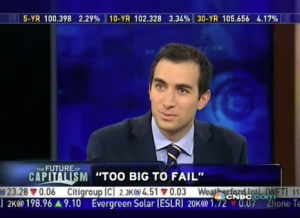Last week my former Associated Press client Tori Ekstrand invited me to speak at the School of Journalism & Mass Communication at the University of North Carolina at Chapel Hill. After a two–hour snow delay in New York, I finally made my way to the Freedom Forum Center on campus where Tori, now an assistant professor, and a handful of her undergraduate students gathered to hear my point-of-view on the evolution of the communications industries.
In a nutshell, I explained, we’ve entered an age when every company and every individual is a media outlet with the capacity to create and syndicate content. At the same time, nimble media upstarts with names like Buzzfeed, Politico, Huffington Post, TechCrunch, TMZ, Drudge, and a myriad others have mastered the art of headline histrionics. In so doing, they have siphoned off a growing share of the public’s ever-divided attention spans from legacy media, which today are struggling to retain the influence they historically have enjoyed.
I was surprised to learn from Tori that some 60-70% of the students in UNC’s journalism program are not majoring in journalism at all. Instead, they’re pursuing careers in advertising and public relations, which may be a smart move given the economic challenges the media industry continues to endure, i.e., Maureen Dowd’s column in The New York Times, and the industry’s embrace of new hybrid ad/edit revenue-generating schemes such as “native advertising†and sponsored content.
Separately, I had forgotten that Talking Biz News’ founder Chris Roush was a senior associate dean and the Walter E. Hussman Sr. Distinguished Scholar in Business Journalism at the university. Talking Biz News is a must-read for those working as or with business journalists. Chris invited me to pen a post for the site on “what’s wrong with the relationship between PR people and business journalists.â€
Clearly there’s much wrong in this symbiotic relationship, but it doesn’t end with the business/financial news beat. The historical love-hate relationship between journalists and PR professionals has taken a distinct turn toward the latter in recent years and infects nearly every media beat. There are a number of reasons fueling the growing acrimony between the two professions, or at least the short fuses journalists have for many PR operatives:
- The ratio of PR people to “pitchable†journalists is now estimated at 4 to 1, resulting in email inbox overload.
- New data-driven vendors let PR pros automate the media relations process, producing greater volumes of misguided or inane story pitches.
- Journalists have many other sources for story ideas, including those they follow in real-time on Twitter and Facebook.
- Media relations is pushed to junior staffers at many big agencies — and in-house communications departments — with relatively little supervision or mentoring.
- Journalists are asked to produce more, often in different mediums. Hence, they’re under tremendous pressure and have less tolerance for wayward story pitches.
 |
| Andrew Ross Sorkin |
Even so, I have to disagree with Chris’s premise that the relationship between PR people and business journalists is completely broken. The New York Times’s Andrew Ross Sorkin, The Wall Street Journal’s Peter Kafka, CNBC’s Maria Bartiromo, Bloomberg News, Reuters, the FT and countless others – including local media outlets — frequently turn to those in the PR profession they’ve come to trust for delivering timely and accurate information.
The relative number of these trustworthy and reliable PR pros may have dwindled in recent years, but I assure you that time and information-strapped reporters and TV producers still appreciate the value offered by responsive PR pros who “get it.â€
In fact, as much as has changed in building a client’s “media” presence, the discipline of “earned media,†as it has become known, is alive and well and still drives the fortunes of the vast majority of PR organizations. Call it what you will – media relations, publicity, influencer engagement, story pitching – the task of capturing the affections of beleaguered journalists thrives.
As a honed art, however, media relations has seen better days. Here are wish lists from each side of the media relations equation.
Journalists to the PR professional:
- Do not send me a story pitch without first researching what I cover.
- Think twice about sending the same story pitch to multiple reporters, and again, know what each and every person on the receiving end covers.
- Please refrain from sending me a manifesto. If you cannot articulate the story in a couple of sentences, then don’t bother sending.
- Keep your email subject line newsy, not cutesy.
- Take the time to learn and understand what exactly you are pitching. Be able to answer basic questions about your client’s business.
- Deliver on the promise, i.e., don’t offer an executive for an interview and then not be able to produce him or her.
PR professionals to journalists:
- In spite of the overwhelming number of pitches landing in your inbox, please do your best to reply, especially if the story idea is editorially valid. We just seek closure, good or bad.
- If the pitch is not in your specific coverage area, but still viable, please consider forwarding to an appropriate colleague.
- Please recognize that if you ignore reasonably news or feature-worthy overtures, we are at liberty to take the story idea elsewhere.
- Please also know that we will do our best to run down the information or interviews you need when you’re in a bind.
- Just as you have a job to do, so do we. Civility goes a long way.
Of course, today’s savviest communications professionals no longer are solely reliant on (and suppliant to) editorial gatekeepers to have their clients’ stories or POVs shared. Communications pros now have the creative capacity and a range of publicly accessible media platforms to deliver content directly to end audiences, bypassing the media filter altogether. Oreo anyone?
Does the profession (and its clients) still covet a feature or mention in Fortune, Vanity Fair, ABC “GMA,” TechCrunch, or on the Dow Jones news wire? You bet. But as public consumption of news and information migrates to mobile and social, PR pros no longer have to endure the indignity of getting dissed by a stressed out reporter or talent booker who paints all PR people as evil. Alternative means for engaging the public through privately produced (i.e., “owned”) media are on the rise — for better or worse (depending on which side of the media equation you ask).


Author – genius! I totally agree with him! Author read my mind!